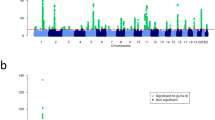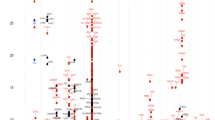Abstract
We conducted a genome-wide association study in 939 individuals with atopic dermatitis and 975 controls as well as 270 complete nuclear families with two affected siblings. SNPs consistently associated with atopic dermatitis in both discovery sets were then investigated in two additional independent replication sets totalling 2,637 cases and 3,957 controls. Highly significant association was found with allele A of rs7927894 on chromosome 11q13.5, located 38 kb downstream of C11orf30 (Pcombined = 7.6 × 10−10). Approximately 13% of individuals of European origin are homozygous for rs7927894[A], and their risk of developing atopic dermatitis is 1.47 times that of noncarriers.
This is a preview of subscription content, access via your institution
Access options
Subscribe to this journal
Receive 12 print issues and online access
$209.00 per year
only $17.42 per issue
Buy this article
- Purchase on Springer Link
- Instant access to full article PDF
Prices may be subject to local taxes which are calculated during checkout



Similar content being viewed by others
References
Taylor, B., Wadsworth, J., Wadsworth, M. & Peckham, C. Changes in the reported prevalence of childhood eczema since the 1939–45 war. Lancet 2, 1255–1257 (1984).
Cookson, W. The alliance of genes and environment in asthma and allergy. Nature 402, B5–B11 (1999).
Schultz Larsen, F. Atopic dermatitis: a genetic-epidemiologic study in a population-based twin sample. J. Am. Acad. Dermatol. 28, 719–723 (1993).
Bieber, T. Atopic dermatitis. N. Engl. J. Med. 358, 1483–1494 (2008).
Price, A.L. et al. Principal components analysis corrects for stratification in genome-wide association studies. Nat. Genet. 38, 904–909 (2006).
Barrett, J.C. et al. Genome-wide association defines more than 30 distinct susceptibility loci for Crohn's disease. Nat. Genet. 40, 955–962 (2008).
Schreiber, S., Rosenstiel, P., Albrecht, M., Hampe, J. & Krawczak, M. Genetics of Crohn disease, an archetypal inflammatory barrier disease. Nat. Rev. Genet. 6, 376–388 (2005).
Pugh, S.M. et al. Atopic disease in ulcerative colitis and Crohn's disease. Clin. Allergy 9, 221–223 (1979).
Hammer, B., Ashurst, P. & Naish, J. Diseases associated with ulcerative colitis and Crohn's disease. Gut 9, 17–21 (1968).
Dixon, A.L. et al. A genome-wide association study of global gene expression. Nat. Genet. 39, 1202–1207 (2007).
Hughes-Davies, L. et al. EMSY links the BRCA2 pathway to sporadic breast and ovarian cancer. Cell 115, 523–535 (2003).
Mischke, D., Korge, B.P., Marenholz, I., Volz, A. & Ziegler, A. Genes encoding structural proteins of epidermal cornification and S100 calcium-binding proteins form a gene complex (“epidermal differentiation complex”) on human chromosome 1q21. J. Invest. Dermatol. 106, 989–992 (1996).
Palmer, C.N. et al. Common loss-of-function variants of the epidermal barrier protein filaggrin are a major predisposing factor for atopic dermatitis. Nat. Genet. 38, 441–446 (2006).
Weidinger, S. et al. Filaggrin mutations, atopic eczema, hay fever, and asthma in children. J. Allergy Clin. Immunol. 121, 1203–1209 (2008).
Nomura, T. et al. Unique mutations in the filaggrin gene in Japanese patients with ichthyosis vulgaris and atopic dermatitis. J. Allergy Clin. Immunol. 119, 434–440 (2007).
Morar, N., Cookson, W.O., Harper, J.I. & Moffatt, M.F. Filaggrin mutations in children with severe atopic dermatitis. J. Invest. Dermatol. 127, 1667–1672 (2007).
Thurmond, R.L., Gelfand, E.W. & Dunford, P.J. The role of histamine H1 and H4 receptors in allergic inflammation: the search for new antihistamines. Nat. Rev. Drug Discov. 7, 41–53 (2008).
Nagai, Y. et al. Requirement for MD-1 in cell surface expression of RP105/CD180 and B-cell responsiveness to lipopolysaccharide. Blood 99, 1699–1705 (2002).
Pearce, E.L. et al. Control of effector CD8+ T cell function by the transcription factor Eomesodermin. Science 302, 1041–1043 (2003).
Hanifin, J.M. & Rajka, G. Diagnostic features of atopic dermatitis. Acta Derm. (Stockholm) 92(Suppl.), 44–47 (1980).
Williams, H.C. et al. The U.K. Working Party's diagnostic criteria for atopic dermatitis. I. Derivation of a minimum set of discriminators for atopic dermatitis. Br. J. Dermatol. 131, 383–396 (1994).
Krawczak, M. et al. PopGen: population-based recruitment of patients and controls for the analysis of complex genotype-phenotype relationships. Community Genet. 9, 55–61 (2006).
ETAC Study Group. Allergic factors associated with the development of asthma and the influence of cetirizine in a double-blind, randomised, placebo-controlled trial: first results of ETAC. Early Treatment of the Atopic Child. Pediatr. Allergy Immunol. 9, 116–124 (1998).
Hill, D.J. et al. Confirmation of the association between high levels of immunoglobulin E food sensitization and eczema in infancy: an international study. Clin. Exp. Allergy 38, 161–168 (2008).
Purcell, S. et al. PLINK: a tool set for whole-genome association and population-based linkage analyses. Am. J. Hum. Genet. 81, 559–575 (2007).
Heath, S.C. et al. Investigation of the fine structure of European populations with applications to disease association studies. Eur. J. Hum. Genet. 16, 1413–1429 (2008).
Fisher, R.A. Statistical Methods for Research Workers (Oliver & Boyd, Edinburgh, 1932).
Petitti, D.B. Meta-Analysis, Decision Analysis and Cost-Effectiveness Analysis: Methods for Quantitative Synthesis in Medicine (Oxford, New York, 1994).
Purcell, S., Cherny, S.S. & Sham, P.C. Genetic Power Calculator: design of linkage and association genetic mapping studies of complex traits. Bioinformatics 19, 149–150 (2003).
Chen, W.M. & Deng, H.W. A general and accurate approach for computing the statistical power of the transmission disequilibrium test for complex disease genes. Genet. Epidemiol. 21, 53–67 (2001).
Acknowledgements
We thank all subjects with eczema, families and physicians for their participation. We thank I.v. Gwinner-Bühring, F. Kussebi, C. Ockeloen, T. Schilling and I. Schulz for subject evaluation. We are grateful to C. Flachmeier, S. Kolberg, M. Schwarz, I. Szangolies, S. Blachut, G. Born, S. Schmidt, C. v.d. Lancken, T. Henke, B. Fedders and T. Wesse for technical assistance, and to M. Wittig for database management. We thank L. Ghys and M. De Longueville (UCB Pharma) and the following EPAAC and ETAC investigators for providing case samples: O. Rybnícek (Brno, Czech Republic), J. Chládková, T. Chyba (Hradec Kralove, Czech Republic), F. Kopriva (Olomouc, Czech Republic), O. Škopková, V. Balcárek (Ostrava, Czech Republic), H. Honomichlova, P. Honomichlová-Houdkova, P. Honomichl (Plzen Lochotin, Czech Republic), M. Špicáková, S. Kynclova, V. Petru, A. Carbolova, K. Kopecká, P. Pohunek, T. Svobodova, V. Špicák, K. Kopecka, M.Maltulka (Praha, Czech Republic), M. Kaczmarski, B. Cudowska, J. Wasilewska, E. Matuszfewska (Bialystok, Poland), T. Malaczynska, B. Klajna-Kraluk (Gdansk, Poland), J. Sokalska, E. Masnica-Wasylkowska, I. Biegun-Awramineko, M. Chlon (Gliwice Poland), T. Latos, E. Pomaranska, G. Gaszczyk, B. Makuch, J. Stanisz, J. Bokiej (Karpacz, Poland), G. Lis, E. Cichocka-Jarosz, I. Glodzik, T. Szczerbinski (Kraków, Poland), D. Chlebna-Sokol, A. Stanczyk, J. Wlazlowski, I. Ligenza, B. Kamer, K. Pyziak, R. Pasowska, J. Zwaigzne-Raczynska (Lodz, Poland), A. Emeryk, H. Milanowska, G. Zywicka, M. Bartkowiak-Emeryk, E. Chojna (Lublin, Poland), A. Swiatly, A. Szczawinska-Poplonyk, M. Kulesza-Kazecka, J. Alkiewicz, A. Breborowicz (Poznan, Poland), R. Kurzawa, A. Wojcik, U. Jedrys-Klucjasz, E. Urbanek-Jozwik (Rabka Zdrój, Poland), L. Dymek, A. Dymek, A. Bozek (Strzelce opolskie, Poland), D. Chmielewska-Szewczyk, J. Lange, J. Peradzynska, M. Kulus, E. Najberg, E. Nowicka, A. Chrupek (Warszawa, Poland), A. Boznanski, E. Willak-Janc, A. Latkowska, E. Sikorska, M.T. Jarlinska (Wroclaw, Poland). The study was funded by the German Ministry of Education and Research (BMBF) through the Clinical Research Group for Allergy at Charité Berlin, the National Genome Research Network (NGFN), by the PopGen biobank and infrastructure support through the DFG cluster of excellence “Inflammation at Interfaces”. This work was supported by an EMBO long-term fellowship (522-2006) and by a Marie Curie EIF fellowship (039868) to J.E.G. N.N. was supported by grants from the German Research Council (DFG NO454/1-4, NO454/2-4, NO454/5-2, SFB704 TPA4) and BONFOR grants of the University of Bonn. S.W. was supported by research grants KKF-07/04 and KKF-27/05 of the University Hospital Rechts der Isar, Technische Universität München, a grant from the Wilhelm-Vaillant-Stiftung and a Heisenberg fellowship (DFG WE 2678/4-1) from the German Research Council. M.M. was supported by research grant VZFNM00064203.
Author information
Authors and Affiliations
Contributions
J.E.G., Y.A.L., S.W., A.R. and N.H. designed the study. Y.A.L. directed the study. Y.A.L., J.E.G., S.W., R.F.-H., U.W., S.S., N.N., M.L.-K., A.C., M.K., T.P. and M.M. provided the case and control samples. J.E.G., S.W., A.R., G.P., A.F., R.V., H.B., T.I. and Y.A.L. contributed to biobanking and management of clinical data. J.E.G., G.P., I.M., F.S. and T.K. performed 500K array and Taqman genotyping. A.R. did the SNPlex genotyping; E.R. contributed to DNA extraction, biobanking and FLG genotyping of Munich samples. A.B., F.R., K.R., J.E.G., N.H. and Y.A.L. conducted all statistical analyses and interpreted the data. S.H. estimated population stratification in set 4. J.E.G. and Y.A.L. wrote the manuscript.
Corresponding author
Supplementary information
Supplementary Text and Figures
Supplementary Methods, Supplementary Tables 1–4 and Supplementary Figures 1–3 (PDF 1496 kb)
Rights and permissions
About this article
Cite this article
Esparza-Gordillo, J., Weidinger, S., Fölster-Holst, R. et al. A common variant on chromosome 11q13 is associated with atopic dermatitis. Nat Genet 41, 596–601 (2009). https://doi.org/10.1038/ng.347
Received:
Accepted:
Published:
Issue Date:
DOI: https://doi.org/10.1038/ng.347
This article is cited by
-
Rare variant analysis in eczema identifies exonic variants in DUSP1, NOTCH4 and SLC9A4
Nature Communications (2021)
-
Identification of the distribution of human endogenous retroviruses K (HML-2) by PCR-based target enrichment sequencing
Retrovirology (2020)
-
Polymorphisms in the airway epithelium related genes CDHR3 and EMSY are associated with asthma susceptibility
BMC Pulmonary Medicine (2020)
-
Predictive in silico binding algorithms reveal HLA specificities and autoallergen peptides associated with atopic dermatitis
Archives of Dermatological Research (2020)
-
The epithelial immune microenvironment (EIME) in atopic dermatitis and psoriasis
Nature Immunology (2018)



